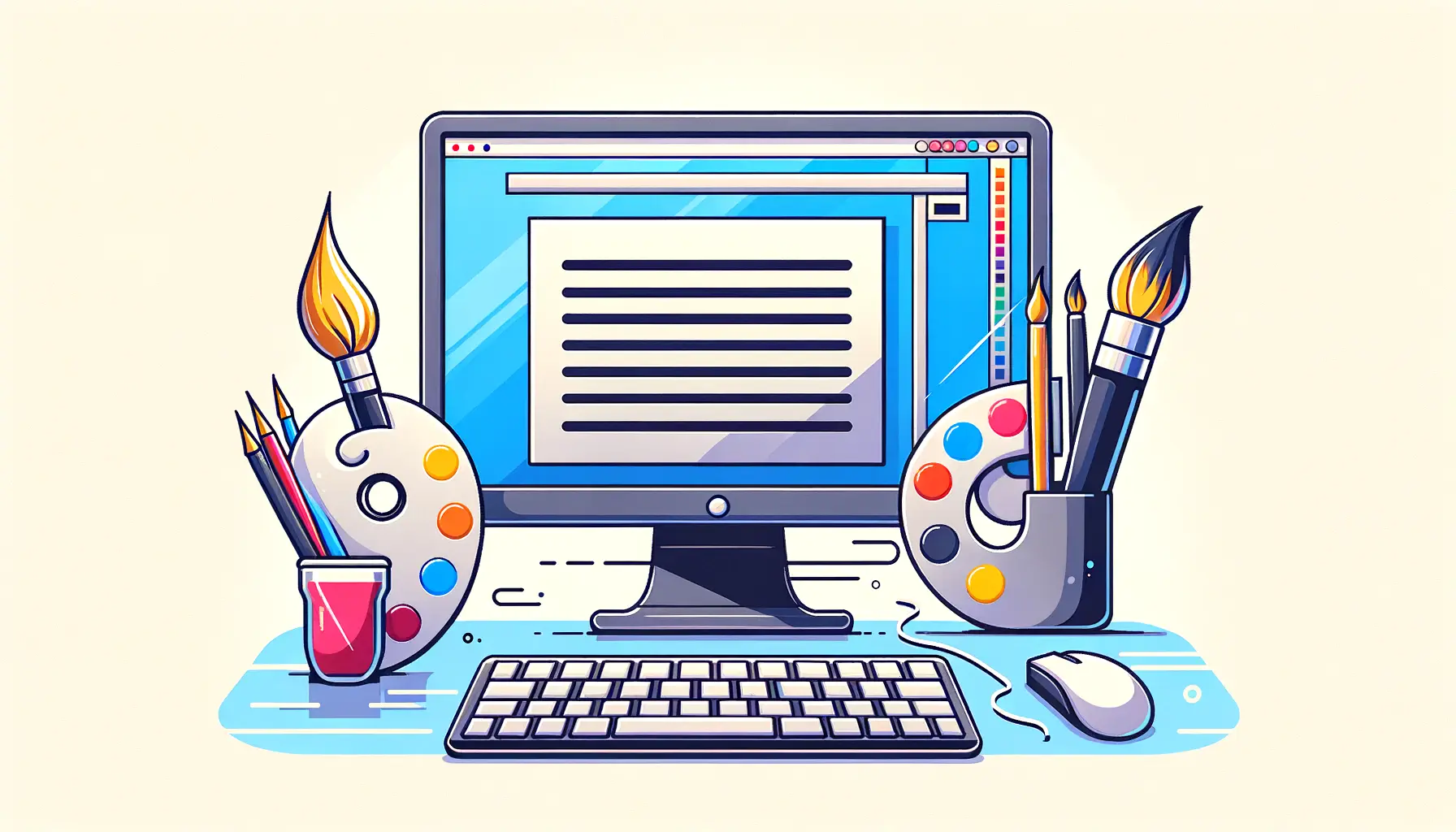Font pairing in web design is not just a matter of choosing two attractive typefaces and hoping they work together.
It’s an art that involves matching fonts in such a way that they complement each other, enhance the overall aesthetic of the website, and contribute to a coherent brand identity.
The right combination of fonts can significantly impact the user’s experience, making the content not only more enjoyable to read but also more effective in conveying the intended message.
This intricate balance between aesthetics and functionality is what makes font pairing a crucial aspect of web design.
Understanding the nuances of font pairing requires a deep dive into typography and its role in digital spaces.
Typography in web design goes beyond just the choice of fonts; it encompasses the arrangement, style, and appearance of text.
It’s a powerful tool that designers use to create hierarchy, guide the user’s eye, and establish the tone of the website.
Effective font pairing can elevate a design from ordinary to exceptional, making it essential for designers to master this skill.
- Understanding Typography and Font Pairing
- Key Factors in Choosing Font Pairings
- Exploring Font Pairing Strategies
- Implementing Font Pairings in Web Design
- Challenges in Font Pairing and Solutions
- Advanced Techniques in Font Pairing
- Exploring Font Pairing Tools and Resources
- Mastering the Art of Font Pairing in Web Design
- FAQs on Font Pairing in Web Design
Understanding Typography and Font Pairing
Before delving into the specifics of font pairing, it’s important to grasp the basics of typography.
Typography is the art and technique of arranging type to make written language legible, readable, and appealing when displayed.
It involves choosing typefaces, point sizes, line lengths, line-spacing (leading), and letter-spacing (tracking), and adjusting the space between pairs of letters (kerning).
The goal of typography is to visually communicate a message in a way that enhances the user’s experience.
Font pairing, a subset of typography, is the practice of selecting two or more fonts to use together in a design.
The key to successful font pairing is finding fonts that complement each other while also serving the content’s purpose.
This can mean pairing a bold, attention-grabbing font for headings with a simple, readable font for body text, or combining fonts that share a similar style or mood.
The right pairings can help establish a visual hierarchy, set the tone of the website, and ensure that the text is both beautiful and functional.
Principles of Effective Font Pairing
Several principles guide the process of effective font pairing.
Contrast is one of the most important factors; it ensures that the paired fonts have distinct roles within the design, making the text more dynamic and engaging.
Another principle is harmony, where the chosen fonts share certain characteristics, such as x-height or stroke weight, creating a cohesive look and feel.
Additionally, functionality cannot be overlooked; the fonts must be legible and appropriate for the medium, ensuring that the text is accessible to all users.
Understanding these principles is just the beginning.
The real challenge lies in applying them to create successful font pairings that enhance the user experience and contribute to a website’s overall design.
It’s a skill that requires practice, experimentation, and a keen eye for detail.
But when done right, font pairing can transform a web design, making it not only visually appealing but also more effective in communicating its message.
Remember, the goal of font pairing is not just to select two beautiful typefaces but to choose fonts that work together to enhance the design and readability of your website.
Key Factors in Choosing Font Pairings
Choosing the right font pairings for a web design project involves considering several key factors.
These factors ensure that the fonts not only look good together but also support the usability and readability of the site.
Here’s a closer look at what to consider when pairing fonts:
Font Family Categories
Understanding the different categories of font families is crucial in making informed pairing decisions.
The main categories include serif, sans-serif, script, and display fonts.
Each category has its unique characteristics and is suitable for different design contexts.
For instance, serif fonts are often used for more traditional or formal content, while sans-serif fonts offer a cleaner, more modern look.
Contrast and Compatibility
Contrast is vital in font pairing, as it helps to create a visual hierarchy and guide the reader’s attention to different parts of the content.
However, the fonts must also be compatible, sharing a certain degree of visual harmony.
This balance between contrast and compatibility is key to creating effective font pairings.
- Visual Hierarchy: Use contrasting fonts to define a clear visual hierarchy, making it easy for users to navigate the content.
- Harmony: Choose fonts that share a similar mood or theme, ensuring that the design feels cohesive.
Readability and Legibility
The primary goal of any text on a website is to be read.
Therefore, readability and legibility are paramount when selecting font pairings.
A good pairing should ensure that text is easy to read at various sizes and on different devices.
This means considering factors like font size, line height, and letter spacing.
- Font Size: Ensure that the main body text is large enough to be read comfortably by your target audience.
- Line Height: Adequate spacing between lines improves readability, especially for longer passages of text.
- Letter Spacing: Adjusting the space between characters can help make a font more legible, particularly at smaller sizes.
Context and Purpose
The context in which the fonts will be used is another critical consideration.
The purpose of the text—whether it’s for headlines, body text, or calls to action—can greatly influence the choice of fonts.
Additionally, the overall tone and message of the website should be reflected in the font pairings, ensuring that they contribute to the site’s communication goals.
- Headlines vs. Body Text: Bold or distinctive fonts can capture attention in headlines, while simpler, more readable fonts are better suited for body text.
- Brand Identity: Font pairings should align with the brand’s identity and values, reinforcing the message the website aims to convey.
Effective font pairing is a balance of art and science, requiring a deep understanding of typography principles, an eye for design, and consideration of the content’s context and purpose.
Exploring Font Pairing Strategies
Developing a strategy for pairing fonts can streamline the design process and lead to more cohesive and effective outcomes.
Here are several strategies that designers can employ to find the perfect font pairings for their web projects:
Mixing Serif and Sans-Serif Fonts
One of the most popular and reliable strategies for font pairing is to mix serif and sans-serif fonts.
This combination offers a balance of tradition and modernity, making it suitable for a wide range of web designs.
The key is to ensure that the serif font brings warmth and character to headings, while the sans-serif font provides clarity and simplicity for body text.
- Example Pairing: A classic serif font like Times New Roman for headlines paired with a clean sans-serif font like Helvetica for body text.
- Application: This strategy works well for editorial websites, blogs, and any site aiming for a balance between approachability and authority.
Utilizing Font Superfamilies
Font superfamilies offer a wide range of styles and weights within the same overarching design.
Utilizing different members of a superfamily for headings, body text, and accents can create a highly cohesive look while maintaining visual interest and hierarchy.
- Example Pairing: Using different weights and styles of a versatile superfamily like Roboto, which includes serif, sans-serif, and condensed versions.
- Application: Superfamilies are particularly useful for complex web projects that require a variety of text styles, such as corporate websites or online magazines.
Contrasting Font Weights and Styles
Playing with font weights and styles within the same family or between complementary families can create subtle yet effective contrasts.
This strategy involves pairing a bold or italic font for emphasis with a regular weight font for body text, creating a dynamic but harmonious look.
- Example Pairing: A bold or italic variant of a font for subheadings or callouts paired with the regular variant for the main text.
- Application: This approach is ideal for minimalist designs where subtlety is key, such as portfolios or minimalist blogs.
Pairing Based on Geometric Forms
Fonts that share similar geometric forms or structures can also pair well together.
This strategy involves identifying the underlying shapes that make up the letterforms and pairing fonts that share these characteristics, resulting in a visually cohesive pairing.
- Example Pairing: Pairing a geometric sans-serif font like Futura with a rounded sans-serif font like Raleway, which both share clean lines and simple forms.
- Application: Suitable for modern, design-focused websites that aim to convey simplicity and innovation.
While these strategies provide a starting point, the best font pairings often come from experimentation and a willingness to break the rules in pursuit of unique and compelling designs.
Implementing Font Pairings in Web Design
Once you’ve selected your font pairings, the next step is to implement them effectively within your web design.
This involves more than just applying the fonts; it requires careful consideration of how they interact with other design elements and contribute to the user experience.
Here are some practical tips for implementing font pairings in web design:
Establishing a Clear Hierarchy
The primary function of font pairing is to establish a visual hierarchy that guides the user through the content.
This means using font size, weight, and style to differentiate between headings, subheadings, body text, and calls to action.
A clear hierarchy makes your content more scannable and improves the overall readability of your site.
For example, a large, bold font can be used for main headings, a less prominent, perhaps italicized font for subheadings, and a simple, legible font for body text.
This layering of typography helps users understand the structure and importance of the information presented.
Consistency Across Pages
Maintaining consistency in font usage across all pages of a website is crucial for creating a cohesive user experience.
This doesn’t mean every piece of text should look the same, but the rules established for your font pairings should apply universally.
Consistency in font pairing reinforces your brand identity and makes your site more navigable.
Ensure that headings, body text, and other elements like buttons and captions are consistently styled throughout your site.
This consistency helps users quickly familiarize themselves with your site’s layout and design, making navigation more intuitive.
Responsive Typography
With the variety of devices used to access websites today, responsive typography has become a necessity.
Your font pairings should be as effective on a mobile device as they are on a desktop.
This means adjusting font sizes, line heights, and spacing for different screen sizes to ensure that your text remains legible and well-structured.
Employ media queries in your CSS to adjust typography based on the device’s screen size.
This might involve increasing font sizes for smaller screens to improve readability or adjusting line heights to ensure that text doesn’t appear cramped on mobile devices.
Optimizing for Performance
The performance of your website can be significantly impacted by the fonts you choose.
High-quality fonts can be large files, especially if you’re using multiple font families with various weights and styles.
To ensure that your font pairings don’t slow down your site, it’s important to optimize font delivery.
Use font hosting services that offer performance optimization, such as Google Fonts, or consider subsetting fonts to include only the characters you need.
Additionally, ensure that fonts are loaded asynchronously to prevent them from blocking the rendering of your page.
Effective implementation of font pairings is as much about the technical details as it is about the aesthetic choices. Balancing these aspects can significantly enhance the user experience of your website.
Challenges in Font Pairing and Solutions
While font pairing is a powerful tool in web design, it comes with its own set of challenges.
Recognizing these challenges and knowing how to address them is crucial for any designer.
Here are some common obstacles in font pairing and practical solutions to overcome them:
Finding Complementary Fonts
One of the primary challenges is finding fonts that complement each other well.
With thousands of fonts available, the selection process can be overwhelming.
- Solution: Use font pairing tools and resources available online. Websites like Font Pair help designers by suggesting effective combinations. Additionally, studying the font pairings used in successful designs can provide inspiration and guidance.
Maintaining Readability
Another challenge is ensuring that your font pairings maintain readability across different devices and screen sizes.
- Solution: Prioritize simplicity and legibility in your font choices, especially for body text. Test your designs on various devices to ensure that your text is easily readable. Adjust font sizes, line heights, and spacing as needed for smaller screens.
Achieving a Balanced Hierarchy
Creating a clear and effective visual hierarchy with your font pairings can be tricky, especially when trying to convey the right message to the audience.
- Solution: Use a combination of font sizes, weights, and styles to differentiate between levels of text. Establish a consistent pattern for using these variations throughout your design to guide the user’s eye naturally through the content.
Font Loading Performance
Fonts, especially when used in multiple weights and styles, can impact the loading times of a website, potentially harming the user experience.
- Solution: Optimize font loading by using modern web technologies like font-display swap in your CSS, choosing only the necessary font weights and styles, and considering the use of variable fonts to reduce the number of font files needed.
Staying Within Brand Guidelines
Finding font pairings that align with a brand’s identity and guidelines can limit your options, making it difficult to achieve the desired aesthetic.
- Solution: Work closely with the brand team to understand the flexibility within the guidelines. Explore fonts within the same categories as the brand’s primary fonts to find complementary options that still adhere to the brand’s identity.
Overcoming these challenges requires a blend of creativity, technical knowledge, and strategic thinking. By addressing these issues head-on, designers can create font pairings that enhance both the aesthetics and functionality of their web designs.
Advanced Techniques in Font Pairing
As web design evolves, so do the techniques for effective font pairing.
Advanced strategies can help create more dynamic, engaging, and visually coherent designs.
Here are some sophisticated approaches to consider for your next project:
Creating Contrast with Typography Scale
Using a typographic scale can significantly enhance the contrast and hierarchy of your design.
This involves selecting font sizes according to a scale, such as the Golden Ratio, to ensure harmonious proportion across all text elements.
- Technique: Choose a base font size for body text and scale up or down for headings and subheadings using the chosen ratio. This method ensures a visually pleasing and well-balanced hierarchy.
Experimenting with Color and Fonts
Color can be a powerful tool in font pairing, adding an extra layer of meaning or emphasis to your text.
Experimenting with color contrasts or harmonies can make your font pairings even more effective.
- Technique: Use contrasting colors for headings and body text to draw attention or employ subtle color variations to reinforce the hierarchy without overwhelming the design.
Utilizing Variable Fonts
Variable fonts offer a range of customization options within a single font file, allowing designers to adjust weight, width, and other attributes dynamically.
This flexibility can open up new possibilities for font pairing and typography in web design.
- Technique: Use a variable font for headings and adjust its weight or width to complement the body text font. This approach allows for fine-tuning and can result in a highly customized and cohesive design.
Pairing Fonts from Different Eras
Combining fonts from different historical periods can add depth and narrative to your design.
This technique requires a good understanding of typographic history and an eye for detail to ensure the pairings are coherent and effective.
- Technique: Pair a modern, geometric sans-serif font with a classic serif font from the 18th century for a striking contrast that bridges history and modernity.
Blending Mood and Typography
The mood or emotional impact of a font can greatly influence the effectiveness of your design.
Advanced font pairing involves not just matching forms but also aligning the emotional tones of the fonts with the content and purpose of the website.
- Technique: Choose fonts that not only look good together but also share a similar mood or emotional quality, reinforcing the message and feel of the website.
These advanced techniques in font pairing require experimentation and a willingness to push boundaries. By exploring these strategies, designers can create more nuanced, expressive, and impactful web designs.
Exploring Font Pairing Tools and Resources
In the ever-evolving field of web design, having access to the right tools and resources can significantly streamline the font pairing process.
Whether you’re a seasoned designer or just starting out, these tools can help you find the perfect match for your project.
Here’s a roundup of some invaluable font pairing tools and resources:
Online Font Pairing Tools
Several online platforms offer automated suggestions for font pairings, making it easier to visualize how different combinations might look in your design.
- Google Fonts: Not only does it offer a vast library of free fonts, but it also suggests popular pairings for each font.
- FontPair: A dedicated tool that helps designers pair Google fonts together. It categorizes pairings by type (serif/sans-serif, etc.) for easy browsing.
- TypeWolf: While not a tool in the traditional sense, TypeWolf provides curated lists of font recommendations and real-world examples of font pairings in action.
Typography Guides and Books
For those looking to deepen their understanding of typography and font pairing principles, several guides and books offer comprehensive insights.
- The Elements of Typographic Style: Often referred to as the “typographer’s bible,” this book by Robert Bringhurst dives deep into the art and science of typography.
- Thinking with Type: Ellen Lupton’s guide is a must-read for designers of all levels, offering practical advice on how to use typography effectively in design.
Design Inspiration Websites
Looking at how other designers tackle font pairing can spark inspiration and provide new ideas for your own projects.
- Behance and Dribbble: These platforms showcase a wide range of design projects, including web design, where you can see innovative font pairings in context.
- Awwwards: Known for featuring cutting-edge web designs, Awwwards is a great place to explore how top designers use font pairings to enhance usability and aesthetics.
Font Identification Tools
Ever come across a font in the wild that you’d love to use in your own design?
Font identification tools can help you find out what it is.
- WhatTheFont: By uploading an image, WhatTheFont can help identify fonts used in various designs.
- Font Squirrel Matcherator: Another tool that identifies fonts from images and suggests similar fonts available for download.
While tools and resources can provide a great starting point, the most effective font pairings often come from a designer’s intuition, creativity, and willingness to experiment.
Mastering the Art of Font Pairing in Web Design
The journey through the intricacies of font pairing in web design reveals its undeniable importance in creating compelling, readable, and aesthetically pleasing digital spaces.
As we’ve explored, the art of matching typefaces goes beyond mere aesthetic appeal, touching on the very essence of user experience and brand identity.
The right font pairing can elevate a design, guiding users effortlessly through content while reinforcing the tone and values of the brand.
The Foundation of Effective Design
At its core, font pairing is foundational to effective web design.
It’s a skill that marries the science of readability and the art of visual storytelling, ensuring that every piece of text serves a purpose.
From establishing a clear hierarchy to maintaining consistency across pages, the strategic use of font pairings is crucial.
It’s about finding that perfect balance between form and function, where typography not only looks good but also enhances the usability of the website.
Challenges and Solutions
Navigating the challenges of font pairing—from selecting complementary fonts to optimizing for performance—requires a blend of creativity, technical knowledge, and strategic thinking.
The solutions we’ve discussed, such as leveraging online tools and drawing inspiration from design resources, are invaluable.
Yet, the true mastery lies in a designer’s ability to experiment, to blend intuition with expertise, and to continually adapt to the evolving landscape of web design.
Looking Ahead
The future of font pairing in web design is bright, with advances in technology and typography offering new avenues for creativity and innovation.
Variable fonts, for instance, present exciting possibilities for dynamic and responsive design, allowing for unprecedented flexibility and customization.
As designers, our task is to stay curious, to keep exploring and pushing the boundaries of what’s possible with font pairing.
Final Thoughts
In conclusion, the importance of font pairing in web design cannot be overstated.
It’s a critical element that can significantly impact the success of a website, influencing everything from brand perception to user engagement.
By mastering the art of font pairing, designers can create more engaging, effective, and beautiful websites that stand the test of time.
As we move forward, let us embrace the challenges and opportunities that font pairing presents, using our skills and creativity to shape the future of web design.
Quality web design is key for a great website! Check out our service page to partner with an expert web design agency.
FAQs on Font Pairing in Web Design
Discover answers to common questions about font pairing, a crucial aspect of web design that enhances readability and aesthetics.
Font pairing in web design is the practice of selecting two or more complementary fonts to improve visual harmony and readability.
Font pairing enhances the user experience by establishing hierarchy, improving readability, and reinforcing brand identity.
Consider contrast, compatibility, and context. Mix serif and sans-serif fonts and use tools like Google Fonts for suggestions.
Yes, but limit to three for clarity and cohesion. Ensure each font serves a specific purpose in your design hierarchy.
Overcomplicating designs with too many fonts, neglecting readability, and choosing fonts that clash stylistically are common pitfalls.
Proper font pairing ensures text remains legible and appealing across devices, requiring adjustments in size and spacing for mobile screens.
Yes, online tools like FontPair and TypeWolf offer pairing suggestions and inspiration, simplifying the selection process.
Use design software or web-based tools to test pairings in your layout before finalizing, ensuring compatibility and visual appeal.














